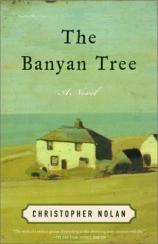The Banyan Tree
Review
The Banyan Tree
Christopher Nolan's bucolic novel, THE BANYAN TREE, is a remarkable achievement from both a literary and personal perspective. One cannot help but be captivated by this book, as I was, after learning that the author is a quadriplegic who writes by tapping key by key with a stick attached to his forehead. Twelve years and a half-million strokes later, the fruit of Nolan's labor is receiving fantastic reviews from people who are pleasantly surprised by the book's elegant simplicity.
The novel tells the life story of Minnie O'Brien, a shopkeeper's daughter, who spends all of her days living in a small town in rural Ireland. There is nothing particularly striking about Minnie --- she is not beautiful, nor is she wise (in fact, she is even a little senile in her old age), nor does she have qualities that make her anything but ordinary. Nevertheless, Nolan manages to engage the reader deeply in the events of Minnie's not-so-eventful 80-plus years. The reader witnesses the entire cycle of her life, beginning with her parents' union and ending with her quiet death. Though plain and simple, Minnie is a strong character, and readers respect her honesty, loyalty, and humility. These qualities strengthen what might normally be an unsympathetic character into a protagonist that readers care about.
Thus, we feel as humbly gratified as she does when Peter O'Brien, a local farmer, chooses Minnie as his wife. Although Peter hides a terrible secret from Minnie, their marriage is a good and solid one. Nolan captures the beauty and intimacy of their simple bond not by sweeping statements about the depth of their feelings, but rather by describing in detail the daily routines they share together. The easy companionship between the two is demonstrated the first day Minnie helps her new husband in what would become the annual task of cutting the peat from Holly Bog.
"Peter the sleansman was tackled and ready, Minnie the catcher, holding her stance, stood waiting. He stood at the turf-face, symbolizing all that was free and flowing in his masculinity. She stood there on the hew stage, ready, willing, and receptive to any flung sods of wet turf. He set up the ballet, she became his ballerina." Despite the difficulty of the daily labor around the farm, the couple set to these tasks with such a oneness of purpose and mind that work did not seem quite like work anymore.
This easy relationship enabled Minnie to explore sexual freedom without shame. She bore Peter two sons and a daughter before he died suddenly of a heart attack. Although she has three children, Minnie finds that she is now utterly alone in the world. These moments in the book are truly heartbreaking as we observe Minnie's struggle to live her life without her only companion. Nevertheless, each painful scene somehow conveys Minnie's fortitude and her ability to endure the loneliness. "She got used to feeling the damp coldness of her late husband's pillow when time and again she rescued it as, lemming-like, it attempted to drop over the edge of the bed." Minnie similarly rescues herself from the despair of this great loss and manages to pull herself from the edge of despair.
Sadly enough, Minnie's family offers her little support through this difficult time. With her eldest children living on their own --- Brendan, a bishop in New York, and Sheila, married to a wealthy man in Dublin --- Minnie and Frankie, the youngest son, stay behind to manage the farm. It is not long, however, before this prodigal son leaves to explore the world, leaving Minnie and her five fields all alone. Our heroine is forced to become entirely self-sufficient, living each day without hesitation. She knows she will live until Frankie comes home to continue her late husband's work. All the while, Minnie protects her land from the clutches of her jealous neighbor, Jude Fortune, and she waits anxiously for a word from the son whose arrival will spell peace and rest for her at last.
Though not exciting or eventful, the novel is both thoughtful and thought provoking. THE BANYAN TREE's beauty lies in the unique blend of elements that unify a simple story --- a willful woman and moving, eloquent language.
Reviewed by Erin Dempsey on February 12, 2002
The Banyan Tree
- Publication Date: February 12, 2002
- Genres: Fiction
- Paperback: 384 pages
- Publisher: Anchor
- ISBN-10: 0385720688
- ISBN-13: 9780385720687








